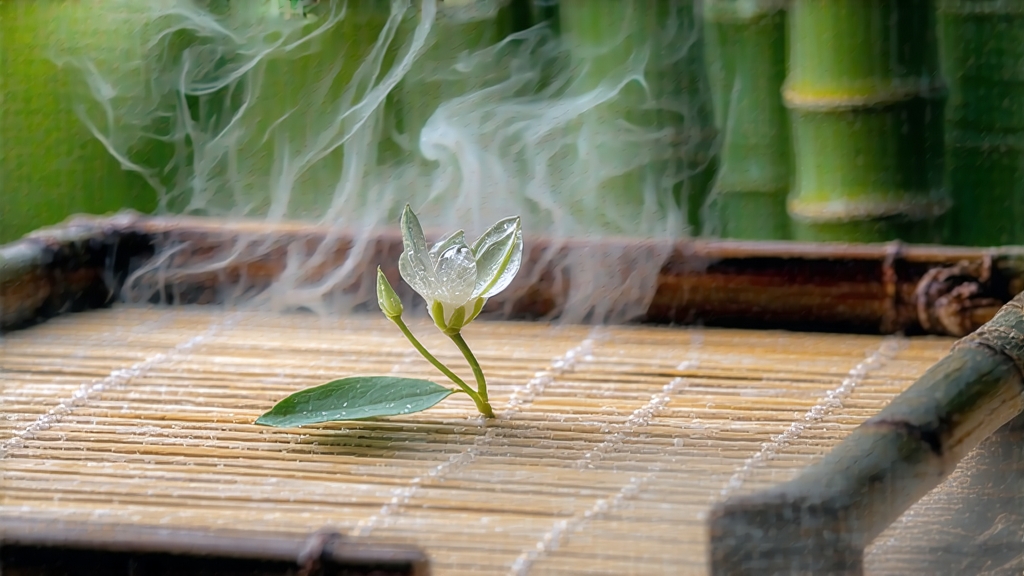
When Chinese tea lovers speak of “white tea,” they are not referring to a pale infusion, but to a whole family of leaves whose silvery down and minimal handling preserve the very breath of the spring mountain. Among this family, Fuding Silver Needle—Bai Hao Yin Zhen in Mandarin—stands as the aristocrat: only the unopened bud, plucked for a few fleeting mornings each early April, is deemed worthy of the name. To understand China’s most discreet yet coveted tea, one must follow the cool mist that rises from the East China Sea and drifts into the granite valleys of Fujian’s Taimu Mountains, where the cultivar Fuding Da Bai Hao has been turning sunlight into downy sweetness for at least a millennium and a half.
Historical whispers place Silver Needle’s birth during the Song dynasty’s imperial gardens, yet credible written records begin in the 1790s, when pressed “white cake” tribute left Fuding county on mule-back for Beijing. By 1857, a royal clerk praised its “jade-white down, snow-bright liquor, orchid-quiet aroma,” and court physicians prescribed it for “clearing inner fire.” International fame arrived late: only after 1891, when European merchants noticed that the buds resisted mold on the long sea voyage from Fuzhou to London, did Silver Needle begin to command higher prices than green tea in Hamburg auctions. Today, protected-origin status restricts authentic Silver Needle to 116 villages scattered across Fuding and neighboring Zhenghe, and every kilo is tracked by laser code from garden to gable-roofed warehouse.
The tea belongs to the “big-white” genetic line, whose buds can swell to 3.5 cm, longer than a sparrow’s beak, and carry up to 15 % silvery trichomes. These hairs are not mere ornament: they are microscopic warehouses of volatile terpenes and amino acids that later translate into the famous “cooling sweetness” Chinese doctors cherish. Picking rules are ruthless: only on days when dew has dried yet the sun is still soft, only buds whose third leaf is still hidden in the sheath, only between 9 a.m. and 2 p.m. when the mountain humidity hovers near 65 %. A skilled plucker can gather just 600 g of fresh buds in a day; 25 000 buds—enough to fill two gaiwans—are needed for 500 g of finished tea.
Once picked, the buds are laid upon thin bamboo trays woven from Taimu mao zhu, stacked in breezy attics whose latticed windows face north. Here they undergo the longest withering in all of tea craft: 48 to 72 hours of quiet conversation between leaf and air. No pan-firing, no rolling, no shaking—only the gentle oxidation that occurs as cellular walls lose moisture and enzymes nudge catechins toward the floral spectrum. Masters judge readiness by touch: a bud must feel “paper-dry outside, silk-moist inside,” and when bent it should sigh, not snap. Final moisture is locked at 8 % using a 20-minute “foot-fire” of charcoal embers buried in ash, a step that adds a whisper of smoked cream without violating white tea’s creed of minimal intervention.
The finished needle is straight as a porcupine quill, ivory at the stem and mercury-bright at the tip. When held to lamplight, the down flashes like ground mother-of-pearl. Aroma in the dry state is surprisingly reticent: cooled rice milk, fresh fennel frond, and something between wet stone and mountain orchid. It is only in the cup that the tea unfurls its full lexicon.
To brew Silver Needle for western palates, begin with soft water whose mineral content stays below 80 ppm; hard water will flatten the amino acids and exaggerate astringency. Heat the kettle to 85 °C—just when the first pearl-sized bubbles cling to the bottom. Weigh 4 g of leaf for a 200 ml porcelain gaiwan; the wide rim allows the buds to stand upright like a miniature bamboo forest. After a swift rinse that wakes the hairs, infuse 25 seconds. The liquor glows pale jonquil, almost colorless against white porcelain, yet the fragrance is immediate: honeydew rind, white peach skin, and a cool note Chinese tasters call “water-iris.” Sip with the tongue curved like a bridge; let the liquid pool under the palate for three heartbeats. The first taste is blankness—then sweetness blooms from